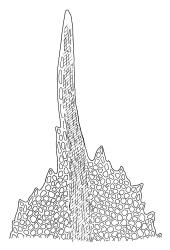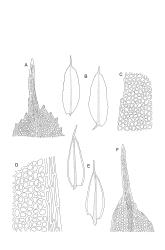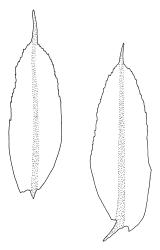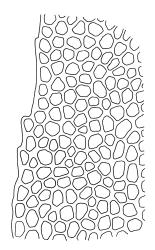- ≡ Fissidens novae-hollandiae Brid., Bot. Zeitung (Regensburg) 1: 212, 234 (1802)
Plants small, dull green, forming turves. Stems prostrate, unbranched, dull green above, usually red-brown near base, c. (8–)10–15 mm, in cross-section elliptic, with 3–5 layers of very thick-walled cortical cells surrounding well- or ill-defined parenchyma cells and an often flattened central strand, beset at base with bright red-brown, smooth rhizoids. Shoots 1.8–2.5 mm wide, complanate when moist, ± conduplicate when dry. Leaves distichous, spreading, asymmetric at base, ovate or oblong-ovate with an acute apex, neither concave nor decurrent, unbordered, serrate above by numerous acute, mostly unicellular teeth, 1.0–1.6 × 0.3–0.4 mm, becoming much smaller and scale-like near stem base. Upper laminal cells firm walled, rounded and ± hexagonal but irregular in outline and size, 0.5–2:1, <15 µm in greater dimension, smooth or with ± prominent cuticular striolations, often a single row at margin somewhat longer (to 3:1), but not forming a distinct border, becoming somewhat more elongate (to 4:1) at extreme base of leaf; alar cells not differentiated. Costa variable in width, 30–60(–75) µm near base, uniformly tapered (usually 30–40 µm in mid leaf), excurrent to form a stout arista (90–300 µm long), in cross-section (at mid leaf) plano-convex (projecting more strongly on abaxial surface), with a central layer of guide cells and elongate superficial cells.
Dioicous. Perichaetia in clusters at base of stem, with leaves lanceolate, costate, c. 1.6 mm. Perigonia red-brown and budlike, in clusters at base of stem, bracts c. 0.5 mm, ecostate, acute from an ovate and concave base, surrounding c. 5 antheridia and filiform, 5-celled paraphyses. Setae 11–30 mm, straight, smooth, twisting to the left, pale brown; capsules horizontal or pendent, oblong-cylindric from a slightly asymmetric base, 1.8–2.1(–2.5) mm, smooth and not or weakly constricted below the mouth when dry, pale yellow-brown, dark brown at mouth; exothecial cells irregular, mostly oblong-hexagonal or quadrate, 1–3:1, with firm, smooth walls; annulus not seen; operculum rostrate from a conic base, c. 1 mm. Exostome teeth pale yellow-brown, narrowly lanceolate, inserted c. 50 µm beneath the rim, c. 500 µm long, bordered, outer surface finely and densely papillose-striolate below, more coarsely papillose-trabeculate above, inner surface lamellate; endostome pale, with a basal membrane ⅓–½ the total endostome height; segments nearly as long as the teeth, keeled but not perforate, papillose-baculate; cilia rudimentary. Calyptra cucullate, c. 2 mm, smooth. Spores ± spherical, 15–18 µm, finely papillose.
NI: N Auckland including offshore islands (LB), S Auckland, Gisborne (Lake Waikaremoana), Wellington. SI: Nelson, Marlborough, Canterbury, Westland, Otago (Leith Valley, Mt. Cargill, Tautuku), Southland; St, Ch, Sol, A, C.
Australasian. Tasmania*, mainland Australia*, Chile*.
Often on tree fern (Cyathea dealbata, Dicksonia squarrosa) caudices and rotten wood, but also occurring on tree bases, exposed roots, rotting logs, and rarely on soil. Libocedrus, Lophozonia, Weinmannia, Metrosideros, and Rhopalostylis appear to be the most common genera of non-tree-fern hosts. Beever (1984) recorded its presence on 93% of Cyathea dealbata, 41% of Dicksonia squarrosa, and 12% of Rhopalostylis sapida trunks in the Waitakere Ranges (N Auckland L.D.) but did not record it from Cyathea medullaris (with 41 trunks examined in detail). Ranging from c. 75 to 1200 m on North I. and from near sea level (Dusky Sound, Southland L.D.) to c. 1000 m (Mt Arthur, Nelson L.D.) on South I; not growing above tree line. Calomnion complanatum and Rhizogonium pennatum are frequent associates.
Populations in the southern parts of the range, growing as epiphytes or on rotten wood and perhaps in drier situations, are often more compact, with stouter costae (to 75 µm wide near leaf base), more striolate cuticles, and shoots more conduplicate (especially when dry) than more northern plants. While such forms viewed in isolation may appear distinctive, they are here considered to fall within the range of variation of the species, and not given taxonomic recognition. A collection by W. Martin from the head of Southwest Arm of Paterson Inlet, Stewart I. exhibits considerable variability with respect to the above characters and also has prominent cuticular striolations. Cuticular striolations were observed for this species by Scott & Stone (1976, p. 312); they appear to be prominent in only a small fraction of N.Z. populations.
There is no type material of Fissidens novae-hollandiae Brid. at BM. Although von Bridel-Brideri's original description has not been located, his description in Bryologia Universa (1827) indicates the type to have been collected by La Billardière, a naturalist on the La Pérouse expedition.
Rhizogonium novae-hollandiae is superficially similar to Calomnion complanatum and depauperate plants of the two are sometimes confused. In such material the number of rows of leaves (two in R. novae-hollandiae, three in Calomnion) can be difficult to observe and the stoutly excurrent costae and the coarser toothing of the leaves of the former are more useful differentiating features. When fertile, the larger, horizontal to pendent, and peristomate capsules of R. novae-hollandiae readily distinguish it from C. complanatum, as does the leaf dispensation. Leptotheca gaudichaudii is also sometimes confused with R. novae-hollandiae, but it is distinguished by having non-complanate shoots, larger vegetative leaves, filamentous brown brood bodies, and erect and striate capsules.







